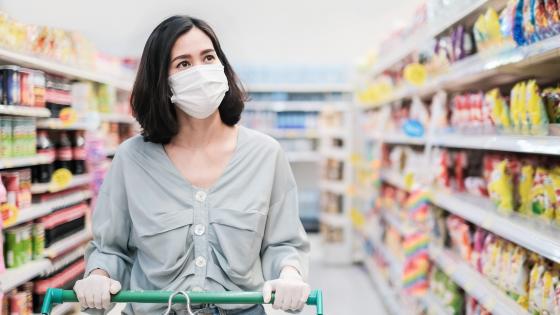The economic costs of the COVID-19 pandemic are staggering: across the globe, millions of people have lost their jobs and trillions of dollars of stock-market wealth has been destroyed.
A key concern for policymakers is the size and nature of the consumer response. While some economists say the shutdown is, in essence, a supply shock with possible spillovers to the demand side (Baldwin and Weder di Mauro 2020, Guerrieri et al. 2020), others stress that the pandemic may also affect demand directly because the health risk of going to public spaces like shops, restaurants, and hairdressers deters consumption (Eichenbaum et al. 2020).
In either case, the dynamics on the demand side may lead to a recession that persists long after the epidemic has ended (Gourinchas 2020). If consumers respond to mass lay-offs, falling asset prices (Gormsen and Koijen), and an uncertain financial outlook (Baker et al. 2020) by slashing private consumption, the epidemic may mark the beginning of a demand-driven economic meltdown. In the face of this risk, governments have initiated massive programmes to support businesses and households.
In a new paper (Andersen et al. 2020), we use transaction data for card spending in Denmark to study consumer responses in the early phase of the COVID-19 crisis. Transactions have a number of advantages over other data sources in this particular context: they are available at any frequency and in near-real time, allowing researchers to analyse sudden changes in spending with little delay. The level of detail is also extremely high, allowing a breakdown of total card spending in detailed categories.
Our analysis uses transaction data for about 760,000 individuals who hold their main current account at Danske Bank, the largest retail bank in Denmark with a customer base that is largely representative of the Danish population.
We estimate the size of the drop in total card spending and analyse how it varies across sectors of the economy with different levels of exposure to the epidemic and the policy measures introduced to contain it. To understand the mechanisms behind the aggregate spending drop, we also study how spending responses vary across individuals who differ in key dimensions, each representing a particular form of exposure to the crisis.
The COVID-19 crisis in Denmark
In the time period we study, from 1 January to 5 April 2020, the crisis in Denmark was unfolding in the same way as in many other countries. The first case was confirmed on 28 February. On 11 March, the government announced a partial shutdown of the economy: all non-essential parts of the public sector – including schools, libraries, and universities – were shut down, and private-sector employees were urged to work from home. One week later, the government announced further restrictions, shutting down shopping centres, hairdressers, and nightclubs and restricting restaurants to take-away service. The timing and severity of the measures were generally comparable to most of Northern Europe, but less restrictive than in Southern Europe where the virus spread more rapidly.
The shutdown was accompanied by measures to financially support households and businesses. Within the first week after 11 March, the Danish government proposed a series of programmes that received unanimous support in the parliament. The programmes were similar in scale and scope to those launched by many other governments in Europe (Anderson et al. 2020).
How much did total card spending drop?
Figure 1 shows the changes in aggregate daily spending in 2020 for the bank’s customers, measured relative to the average value in 2019. For comparison, the figure also shows aggregate spending for a reference day 364 days earlier, which is always the same day of the week and almost exactly the same place in the monthly and annual spending cycle.
Both series are volatile – with a pronounced weekly cycle with spikes around weekends as well as a monthly cycle with spikes around paydays – but they are strikingly similar in the period before the shutdown on 11 March. After the shutdown, however, there is a clear divergence, with 2020 spending falling short of 2019 levels, as indicated by the shaded area.
Figure 1 Aggregate card spending
Notes: The figure shows the evolution of daily average card spending in 2020 (red line) and on equivalent days in 2019 (grey line), where each series is shown as a percentage of average daily card spending throughout 2019. Labelled ‘paydays’ are the final bank day of the month when the majority of individuals in Denmark receive their salary and/or government transfers.
Our headline estimate is that card spending dropped by around 25% in response to the crisis. Figure 2 illustrates how we get at this number: before the 11 March shutdown, daily spending was on average 2% higher in 2020 than on the 2019 reference day.1 After the shutdown, consumers spent 23% less than in the reference period. Under the assumption that the year-on-year growth from 2019 to 2020 would have remained constant absent the crisis, the difference between these two numbers is the causal effect of the crisis on total spending.
Figure 2 The impact of the COVID-19 crisis on aggregate card spending
Notes: The figure illustrates how we estimate the effect of the crisis on total card spending. The left blue bar shows the average difference in daily spending relative to the reference day for the period 1 January–15 February 2020. The middle bar shows the corresponding average for the period 12 March–5 April 2020. The right red bar shows the difference between these averages, which is our headline estimate of the effect of the crisis.
What did consumers cut back on?
Figure 3 shows similar estimates for selected expenditure groups. Spending responses to the shutdown vary widely across categories: spending in grocery shops and pharmacies is moderately elevated relative to the counterfactual (blue bars), whereas spending on restaurant meals, travel, retail, personal services, fuel, and entertainment exhibit pronounced decreases (red bars).
Figure 3 The impact of the COVID-19 crisis on categories of spending.
Notes: The figure shows the impact of the COVID-19 crisis on spending at different categories of merchant, identified using Merchant Category Codes associated with card payments. Each bar shows the estimated impact on daily spending in the indicated category, measured relative to average daily spending in that category in 2019.
Spending responses are closely linked to the restrictions on mobility and activity imposed by the government to prevent the spread of the virus. Figure 4 makes this point more formally by showing estimates of the spending response for three different sectors: an ‘open’ sector where supply was totally unconstrained by government interventions (e.g. supermarkets, pharmacies, online retail); a ‘constrained’ sector where government interventions had some effect on supply (e.g. offline retail where malls were shut down but high-street shops allowed to remain open); and a ‘closed’ sector where the shutdown led to a near-complete elimination of supply (e.g. travel, restaurants, hairdressers, dentists).
Figure 4 Supply constraints
Notes: The figure shows the impact of the COVID-19 crisis on consumer spending in the open, constrained, and closed sectors of the economy under government controls. See Andersen et al. (2020) for details on how we define each sector.
The three sectors fared very differently: we estimate spending responses of around 10% for the open sector, -40% for the constrained sector, and almost -70% for the closed sector.
It is unsurprising that spending on goods and services produced in the closed sector falls: with supply effectively cut off, spending is bound to decline. The modest increase in spending in the open sector (which accounts for around half of the economy) is noteworthy, however, because it suggests a limited role for negative spillovers of supply shocks through the demand side, at least within the relatively short timeframe covered by our analysis.
Who cut back the most?
Figure 5 shows the impact of the COVID-19 crisis on total spending across groups that were differentially exposed to the pandemic and the shutdown. Three points emerge from the figure.
First, individuals who are financially more exposed to the economic fallout from the crisis – because they work in private businesses directly affected by the shutdown or because they own stocks – reduced spending more than the financially less exposed (public sector employees, non-stock owners). But the differences across these groups are quite modest.
Second, the elderly cut back more than younger individuals did. Since the elderly are more likely to suffer severe health consequences if infected with the virus, this suggests a role for exposure to health risk as a driver of the drop in spending.
Third and finally, direct exposure to the shutdown of economic sectors such as restaurants and international travel correlates strongly with the size of the drop in spending during the crisis: individuals who spent most in these sectors before the shutdown reduced card spending by 12 percentage points more than those who spent the least.
Figure 5 Individual heterogeneity
Notes: The figure shows the impact of the COVID-19 crisis on total card spending for groups of individuals who differ in exposure to particular risks associated with the crisis and the shutdown. Observations are weighted so that each group is representative of the full sample in all observable characteristics, except the one highlighted (see Andersen et al. 2020 for details).
These results provide some insights into the mechanisms underlying the massive drop in aggregate spending. Differential exposure to economic risks and health risks can account for some of the variation in spending responses but not nearly all of it. Pre-crisis spending shares on goods and services provided by the closed sector is clearly the strongest correlate of spending responses.
Concluding remarks
The evidence shown above consistently indicates that the closed sector of the economy is at the heart of the drop in consumer spending. In the time period we consider, there is little evidence of massive spillovers to the open part of the economy through reduced consumer demand.
What would have happened if the Danish government had not shut down large parts of the economy on 11 March? On the one hand, the fact that spending reductions are so concentrated in the closed sector – and that economic risks such as income and wealth losses appear to play a modest role – is consistent with the idea that the shutdown was the direct cause behind the drop in spending.
On the other hand, it is also possible that the health risks that motivated the shutdown would have suppressed spending on goods and services produced in the closed sector, even without any government intervention. Under this interpretation, re-opening the economy will not restore economic activity to pre-crisis levels so long as the health risks associated with the COVID-19 epidemic remain.
References
Andersen, A, E Hansen, N Johannesen and A Sheridan (2020), “Consumer responses to the COVID-19 crisis: Evidence from bank account transaction data”, Covid Economics 7: 88–114.
Baker, S, N Bloom, S Davis and S Terry (2020), “COVID-induced economic uncertainty and its consequences”, VoxEU.org, 13 April.
Baldwin, R, and B Weder di Mauro (2020), “Introduction”, in R Baldwin and B Weder di Mauro (eds.), Economics in the time of COVID-19, a VoxEU.org eBook, CEPR Press.
Anderson, J, E Bergamini, S Brekelmans, A Cameron, Z Darvas, M Domínguez Jíménez and C Midões (2020), “The fiscal response to the economic fallout from the coronavirus”, Bruegel Datasets. Retrieved on 7 April 2020.
Eichenbaum, M S, S Rebelo and M Trabandt (2020), “The macroeconomics of epidemics”, CEPR Working Paper DP14520 .
Gormsen, N J, and R S Koijen, (2020), “Coronavirus: Impact on stock prices and growth expectations”, Working Paper, University of Chicago Booth School of Business.
Gourinchas, P O (2020), “Flattening the pandemic and recession curves”, in R Baldwin and B Weder di Mauro (eds.), Mitigating the COVID economic crisis: Act fast and do whatever it takes, a VoxEU.org eBook, CEPR Press.
Guerrieri, V, G Lorenzoni, L Straub and I Werning (2020), “Macroeconomic implications of COVID-19: Can negative supply shocks cause demand shortages?”, Working Paper, University of Chicago Booth School of Business.
Endnotes
1 This number is based on the period from 1 January to 15 February 2020. We exclude the days between 16 February and 11 March from the pre-shutdown period, as early restrictions (e.g. on air travel to Asia) and anticipation of the broader crisis may have affected spending prior to the shutdown.





